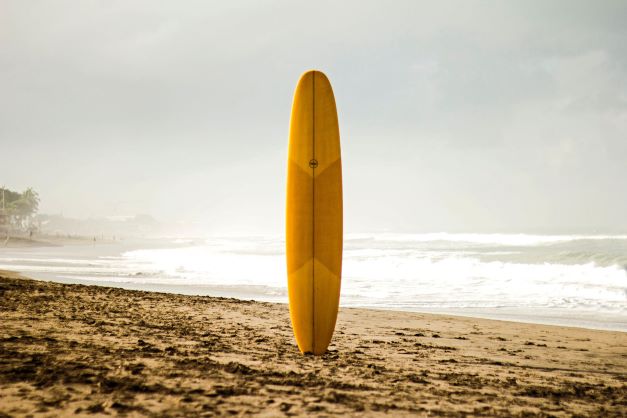The right board for the right wave. The right tool for the right job. Don’t grab your shortboard every day and don’t paddle out to Rincon when it’s 2 foot and overcrowded. There is a time and wave for each board in your quiver. Knowing the right board for different conditions will elevate your surfing to the next level. Board selection is a key factor in determining how your session goes, so you need to learn what to ride in different conditions. Each surfboard design is meant for certain waves, so knowing the differences will help you make the most educated decision.
There are so many different aspects of a surfboard that determines how catches and rides on a wave. I will go through each part of the board, and how it relates to the wave you are on so that you can decide what to wax up. Length, fins, volume, tail shape, rails, and convex vs concave bottom contours are all important parts of a surfboard affecting performance. Understanding comes from experience too. Riding and experiencing different kinds of boards and waves concurrently will give you invaluable knowledge that I can’t teach you. If you don’t have access to a lot of boards, consider renting a surfboard that you don’t normally ride.
Where am I surfing?
This is the most first question to ask yourself before thinking about what board you will be riding. There are not only different types of surf breaks, but the swell angles will affect how the same place may break from swell to swell. If you are planning on checking two different kinds of breaks, then you should bring at least two boards. You wouldn’t take a Big Wave Gun Board to Waikiki on a casual summer day. You just would not have as much fun on the Gun, compared to a 10-foot Noserider. Surfboards have a lot of nuances, so understanding them better will improve your surfing skills because you can understand what the board is meant to do.
With all that being said, two people on the same day may take out drastically different boards. This is mostly a personal preference, however, one of those people will most likely be getting more waves and having better rides. The different surf breaks that you are surfing will have an impact on the surfboard design that you should be riding. However, personal feel and preference are the biggest determinants of what board to ride.
Reef Break
Reefs are incredibly dependent on tides, swell angle, and bathymetry of the reef, as well as the ocean floor leading to the reef. Reefs breaks can be very mellow, gradual breaking waves that are user friendly, or they can look more like this wave at Teahupoo in Tahiti. No matter what kind of spot it is, just observe the wave. You need to learn more about how the wave breaks at that particular spot before knowing what kind of board to ride.
Learn your local reef break(s). If the wave breaks faster and is pretty steep and hollow, a shorter board with more rocker is most likely in order. If the break is a little slower or not breaking fast, a longer board or even a mid-length could be perfect. Remember, the board selection also depends on the style of surfing you hope to do during your session. Sometimes I just really want to longboard, so I take out my 9’0″ single fin just because I want to!
Point Break
Points are what you will run into most in Santa Barbara. Typically rights, the points in Santa Barbara can deliver some incredible surf during the winter months. These waves will typically have a smaller size than beach breaks from the same swell. The point actually disperses the swell throughout the point as the wave refracts, which knocks down the size and cleans up the swell for a cleaner face and better ride. Wave refraction is basically the bending and change of direction of waves as they travel. Waves can refract due to colliding with other waves, hitting the coastline, or traveling over shallower water, causing parts of the swell to slow down and change direction.
Pointbreaks can be excellent for longboarding, or short boarding, and you should know how your point breaks before paddling out. Rincon, for example, really has 3 different spots to surf, and each one breaks differently. This video perfectly shows how different people can ride different boards at Rincon. The inside cove is a mellow and slow longboard wave almost always (when breaking) while indicators and the Rivermouth are more shortboard oriented. That being said, I see all kinds of surfboard design in all three spots, mostly by people that do not know what they are doing. However, if you are an experienced surf
Beach Break
Beach breaks are typically a lot more powerful than a point break. This is because of wave refraction; at beach breaks, waves will funnel into the smallest canyons before breaking into an A-frame going left and right. This is a textbook beach break, but not all beach breaks will be so uniform.
Typically, these kinds of waves will break quickly and be very hollow and break into shallow water. When you are surfing beach break, you are most likely going to be looking for barrels and air sections. These waves need to be caught when the wave is steepest so having a quick popup and a smaller more maneuverable board is key. There are also some folks that like to use a surfboard design that facilitates catching the wave earlier to roll into the steeper section easier. This is some people’s personal preference, but not everybody’s!
What surfboard design do I need?
You should have every possible surfboard design ever made in your quiver… OK not really, but I don’t know what board you need, because everyone rides differently. Different techniques, weight distribution over different feet, stances, etc. are all factors to think about when buying a surfboard. If you are a beginner, much of this will not be as important to look into when getting a surfboard to learn on, but the better you get at surfing, the more you will appreciate a board that is right for you. Knowing what you like to ride is a great help for the shaper making your next board.
There are essentially 4 basic shapes/kinds of surfboards. There are numerous subcategories within all of these categories, but the main categories are shortboards, grovelers, mid-length, and longboard. All of these categories share some similarities with other categories. As a whole, they are used for very different waves and riding styles. What you want to do on the board will dictate what kind of board you want to ride. This will also be moderated by the wave that you are hoping to ride as well. Board type desired, riding style, and wave all interact to dictate what board would be best for you on a particular day.
Longboard Surfboard Design
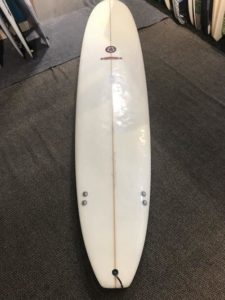
This is pretty self-explanatory; longboards are long! Typically, these boards are 8’6” and longer with most boards being closer to 9’6”. Many longboards are even as long as 12 feet! They are meant to catch smaller gentle waves and have long drawn out turns, or for noseriding. These boards are not necessarily meant to be turned super hard and are more of a casual surfboard. That being said, I think that the best surfers in the world are longboarders. They have so much control over such a larger board that they are able to do some things that a shortboarder would only dream of doing. Notice the way that the surfer below moves on the wave. This break is a very mellow breaking wave with not real steep sections, perfect for a longboard.
Mid-length/Funshape Surfboard Design
Mid-length fun shape surfboards are a must-have board for every surfer in the world because of their versatility and general fun-ness! This surfboard design can be perfect for a variety of different waves from overhead faster point breaks to smaller days in the beach break. I prefer to ride my middy at point breaks on pretty big days. This board allows me to catch the wave sooner, the catch being that paddling out is more difficult. This is where learning your home break well will come in handy. By understanding the wave better, you can time your paddle outs a lot easier to save time and energy. Timing and surfing go hand in hand, so timing the paddle out on a mid-length will save your arms on a bigger day.
Shortboard Surfboard Design
Shortboards are becoming more and more prevalent. The shortboard used to be reserved for the best of the best, but now everybody thinks they need a shortboard to rip like Kelly Slater. This is really not the case. I see way too many people out on boards that they don’t need yet. Your shortboard should be used as a high-performance board that is typically meant for really sharp turns and going more vertical on the wave. Some shortboards are also built more for bigger, faster, barreling waves. Those boards, called step-ups, will have a narrower tail and typically be a little longer. They will allow you to catch waves sooner and hold your line through really fast hollow waves. You sacrifice maneuverability for control with a step-up, but that is exactly what the board is designed to do!
A standard shortboard is typically between 5’6” and 6’2” depending on your own height (and weight). There are some calculators out there that will show you the best length to volume ratio for your standard shortboard. There are many little differences that will change the exact dimensions of the board, such as where the widest point of your board is located, how wide the nose or tail is, as well as the concavity of the bottom of the board.
I prefer my shortboard to be 2”-4” shorter than my height usually. With a shorter board, I also like it to be a little wider to make up for the lost volume. The shorter and wider you get though, the more the board becomes a groveler, which is something that I like to ride a lot.
Groveler Surfboard Design
A groveler is regarded as more of a summer shortboard design for when the waves are smaller and slower. The groveler in your quiver will have a little extra volume in it that will help with catching waves. These boards typically are more loose and maneuverable but aren’t as fast in hollow waves. Grovelers aren’t the highest performance surfboard, but they are super fun when you just want to get in the water when the waves are just OK. That being said, some people can absolutely RIP on grovelers and they make it look way too easy. The wider outline of a groveler allows the board to maintain speed through slower waves and flatter sections. I really think that everyone should be riding grovelers more often instead of their “high-performance” shortboard that many people really don’t need.
Surfboard Tail Design
There are so many kinds of tails that we are seeing on surfboard designs nowadays. I will cover the more basic and broad fitting designs but know that there are so many slightly different tail designs out there. The primary kinds of tails are squash, fish/swallow, and pin, with a few subcategories that I will cover. The tail is a large part of how the board releases water through turns, meaning that the tail is one of the more important things to look at regarding riding style and wave preference.
Squash Tail
Squash tails are by and large the most popular and well-used tail design, for good reason. They are very versatile on multiple lengths and kinds of boards, allowing for both speed and maneuverability. The board will be able to turn harder while still holding well, in addition to being able to pump down the line to make faster sections. All of this depends on the person’s ability level of course.
A square tail is a variation of the squash tail and is more typical on a groveler. This will feel like a squash tail with a little more release in your turns off the top, and with the added foam and foil, this tail is best in smaller surf because of the reduced control that comes from less drag. I consider this the best equivalent to riding a skateboard on water. That reduced control will have an increase in speed through flatter sections as well because of the flat rocker that is often found on grovelers.
Pintails
A pintail on a surfboard is designed almost exclusively for riding down the line with minimal cutbacks and turns. The pintail lets the tail sink more into the water, giving you more hold on the bottom turn and down the line on steeper waves. You will find pintails on almost all step-up and big wave gun surfboards, as well as a few longboards as well.
The longboard’s pintail reduces lift in the tail. This is beneficial for the noserider that wants to keep that tail in the wave while walking to the nose. Technically you lose maneuverability with a pintail, but big wave guns and longboards are not supposed to turn on a dime. These two boards are used for very different wave riding. This perfectly illustrates how different tail designs can be used in a variety of wave conditions.
Thumbtails
Thumbtails (also called a rounded pin) are a great in-between for barrel riding and wide-open faces on point breaks. They will have a lot of hold similar to a pintail, but the roundness of the thumbtail will allow more release and maneuverability for sweeping turns, while still being able to hold in the barrel. This tail is often found on step-up boards as well. The thumbtail is definitely one of the most versatile tails to have on a surfboard, but they are most well-used on those step-up boards on bigger days.
Fish and Swallow Tails
Fishtails and swallowtails are relatively similar to each other. The fishtail is essentially a bigger version of the swallowtail, which is basically two mini pintails side by side. Having two pintails on the back of your board in this orientation allows you to drop into steep waves with more hold than a squash, but still have more maneuverability. When making a bottom turn on this board, you are essentially engaging one of the pintails for increased hold. When you are turning slower and pumping, the increased tail surface area will help propel you forward faster.
Volume, Rocker, and Rails Surfboard Design
How much volume should my board have?
The volume of a surfboard has become a major topic in recent years in the surf industry. The shortboard takeover has led to an increased look into developing surfboards in different ways. Putting foam in different places on the board will make the board paddle and surf differently. Check out this page that has great in-depth information on volume calculation, as well as a super helpful graph (shown below) that makes it a little easier. That being said, there are a lot of small changes that can be made to a board that will alter the volume drastically.
The volume of your surfboard is very relative to weight when we are talking about shortboards and grovelers. Once you get into mid-lengths and longboards, the volume is less important.

How wide should my board be?
The width will always depend on the length of the board, as well as the design of the surfboard. Wider boards will always have more volume and will float you better, but they will typically not be as fast and high-performance. Surfboards are constantly pushing and pulling between control and maneuverability. When one goes down the other goes up, and vice versa. You should also be looking at where the foam and width of the surfboard are more prominent. The placement of this midline and foam drastically affects how the board paddles and catches waves.
Where is the widest part of the board?
If the widest spot across your board is forward from the center of the board, you will see more stability, paddle power, and speed down the line. When the widest part of the board is back from the center of the board, then the board will be more agile, allowing the board to make tighter turns. If the widest point of the board is forward of the center, then the board will have much better paddle power to catch waves and ride through slower spots on a wave. However, you also lose some maneuverability and pivot angles with the extra foam in the front of the board.
The more speed the board is designed for, the less maneuverability the board will have, typically. A Big-Wave Gun is a great example of the extreme side of this. It is specifically designed to paddle and catch waves, and hold their line while racing down the face of the wave at high speeds. You will NEVER see a twin fin gun in the water with a square tail; they are now almost exclusively pintails with quad fin setups in them.
What kind of rocker is on the board?
The rocker is best described as how flat or curved the bottom of the board is from front to back. There are two different parts to the rocker of a surfboard; nose rocker and tail rocker. The nose rocker is more important to catching and dropping into waves. More nose rocker lets you get over bumps on the face of the wave without digging into the water/pearling. You also might see more foam in the nose of a board with less nose rocker. The tail rocker is more important to speed and control of the board while riding the waves. More tail rocker will slow the board down but will let the board pivot and turn much tighter. Less tail rocker will bake the board plane/glide faster but compromise maneuverability on turns.
A flat rocker (no rocker) in general will be a faster board but is much more difficult to turn. A bigger rocker will allow for steeper drops down the face of the wave as well as a tighter turning radius. However, this board will be slower, until you learn to pump and generate your own speed.
Longboards typically have less rocker while shortboards more often have more rocker. A Mini Simmons would be an exception; these boards are typically about 5’-6’ long, very wide, and incredibly flat. Sometimes referred to as a bar of soap, they are the ultimate groveler board for summer waves and slower days. The Mini Simmons is based on a longboard shaper Bob Simmons’ boards which were cut in half occasionally and getting twin fins glassed on. Thus the Mini Simmons was born!
Surfboard Rail Design
The rails on the board determine how the board releases water, thus determining the turning ability and glide of the board. Furthermore, the rails are another place that volume can be increased or decreased in a surfboard. The rails have everything to do with drive and projection on a wave, however, the fins play a very active role as well. Shapers refer to the rails as either hard or soft, typically, and they can be either full or tapered. A tapered rail will blend gradually throughout the length of the board. A full rail will be relatively uniform along almost the entirety of the board’s edge.
Surfers on high-performance boards of any kind are going to be surfing a board with a harder rail. These rails don’t have as much projection through turns, but these surfers typically are able to generate a tremendous amount of speed. A softer rail is most often found on Longboards or grovelers; this will increase the volume of the board as well as help with stability and paddle power into waves.
You will need good surf for harder rails. These boards are meant to be ridden from rail to rail to keep the speed up, but you also need a big and steep enough wave to really work it. A hard rail is really required in bigger punchier surf because this allows the tail to hold in the water better for more sharp turns. If you really want to dive into the rails of a surfboard, check out this blog by Dakota Wienges at Kooks Only!
Bottom Contours
The bottom contours on a surfboard are super important. Think of a surfboard as a wing, and the water passing under the board providing lift. The efficiency and direction of water flow under and off of the board are very important.
Surfboard Fin Design
I am going to be relatively brief on surfboard design fins in this blog. There is honestly just too much information to cover the surfboard fins design and composition in this same blog post. For the purposes of this post, I will just go into the basics, primarily the number of fins, and placement of fins in relation to the back of the board. If you absolutely cannot wait for my blog on fins to come out, check out this post on the Boardcave’s website about surfboard fins.
How do fins affect the board’s movement?
The fins are debatingly one of the most important parts of the board. The fins get manipulated by the weight displacement you put on the board (and where you put your feet on the board) to enact turns and move the board on the wave. They are the traction on the water to turn the board and control speed, in conjunction with the rails of course. When looking at the photos below, check out the small differences in the shape of the fins.
There are numerous fin setups that you can have on any number of boards. Single fins were the original (besides finless), then twin fins came into fashion in the ’70s. Then the thruster exploded during the shortboard revolution opening the door for more radical surfing. Quad setups are another way to have more drive on a board as well as stability but are not as popular on everyday boards in your quiver. 5-fin setups are popping up more often, but these are to allow for different fin options on the same board. The 5 fin set-ups in a board so you can ride it as a quad, twin, thruster, and sometimes as a single fin. The single fin option would only be possible with a bigger fin box in the middle.
Single Fin
The classic single fin. There has been a revival of the single fin over the past few years because it is just so much fun. Using just one fin will have less drag/resistance in the water and will be very fast down the line. You will be sacrificing control with a single fin so your turns will be wider and more drawn out. Most often found on longboards and noseriders, these fins are great for the hold they provide when you don’t need to be as aggressive with your turns. These setups have also become popular on smaller boards for people wanting that feel of a retro single fin. This is more of a novelty board but if you love what you ride then who am I to judge!
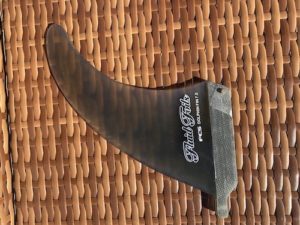
Twin Fins
Twin fin setups are my favorite for those chest to head-high days that are peaky but not too fast. This setup keeps me fast, loose, and having a great time. Twin fins are mostly found on a fish surfboard design, but you may find them on mid-lengths as well. A lot of your turns while on a twin fin are done directly over each fin on the respective side you are turning. These fins will be bigger than your side fins on a thruster setup. This is because you still want a good surface area for the fins to hold against the water. If you love skateboarding in bowls, then a twin fin setup is going to feel semi-comparable in my opinion.
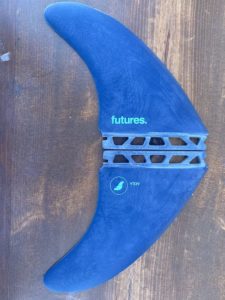
Thruster Setups
The mighty thruster setup; the king of all fin setups on the Championship Tour. Three fins will give you the most control, power, and speed when used properly. This setup is designed to do more aggressive maneuvers and aerials. You don’t need to be a professional surfer to appreciate this setup, but more advanced surfers gravitate towards a thruster more. The center fin on a thruster increases drag, but you will have so much control that you can explode and power through turns if used properly. Pumping on a thruster will also give you great release and speed when done properly. The Jordy Smith Signature Fins below are my go-to for my high-performance shortboard. Plenty of drive with good release off the top. The narrower tip of these fins allows for great snaps off the top of the wave too.
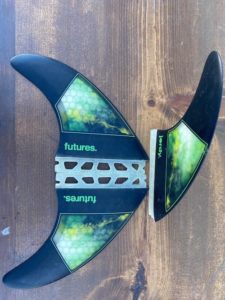
Twin Plus One Setups
This fin design and setup on a surfboard is relatively new. This setup will tend to have more surface area on the outer twin fins, with a third fin in the middle. This middle rear fin is for stability and hold. This allows a board designed as a twin fin to turn into a more high-performance twin fin board. I personally find these really big twin fins with the plus one to grab too much and take away from the flow and playfulness of a twin fin. If you are looking for a more performance twin fin feeling board, then this could be a great option.
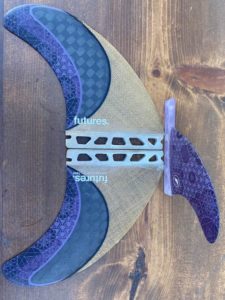
Quad Setups
Quad fin setups are the perfect setup for power surfing. Your board won’t have the drag of a center fin slowing you down, and the two fins on each side work together to build speed. When you are looking at a break and you know you need speed, you need a quad setup. Surfing waves like pipeline as a quad setup is best because your board will hold well while on such a fast wave. Apologies for the bad photo, but these are the only Quad Fins that I have currently.
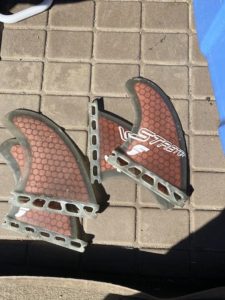
Pyzel Shadow Surfboard Design
I just bought this Pyzel Shadow about a month ago and I absolutely love it. I haven’t used a standard thruster shortboard in a while, and this thing RIPS. Now that I have gone through almost everything about surfboard design, I thought I should bring it all together. I will walk you throw this board from nose to tail, rail to rail, inside and out. There are 8 photos below that will be super helpful as a visual aide while I go through each part.
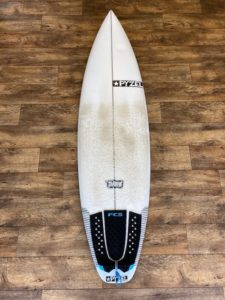
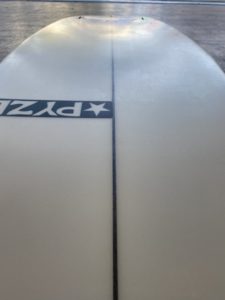
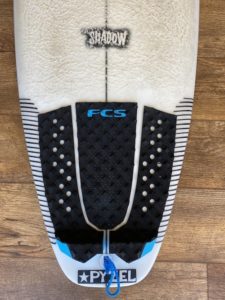
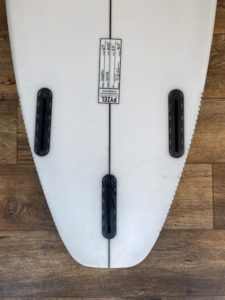
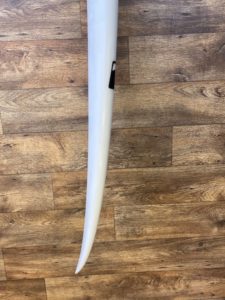
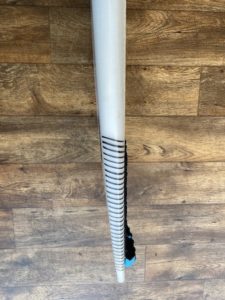
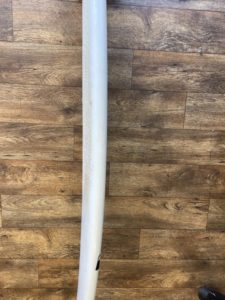
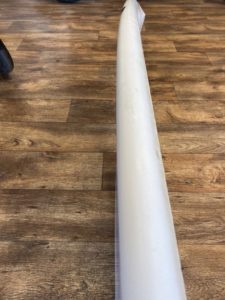
There are a few conclusions that we can draw just by glancing at the photos. This is a shortboard (6’1″) with a thruster fin setup and a squash tail. We can also tell that the board is composed of the standard Polyurethane (PE) because of the stringer. Not all boards with a wood stringer are PE boards, but most PE boards have one. I consider myself an advanced surfer and going off their volume guide, I should be riding something around 30.9 liters. This Shadow is 30.8 liters, and as far as I can tell, it’s perfect!
The Shadow is considered a high-performance shortboard. As can be seen in the bottom left photo, there is quite a bit of nose rocker on this board. This helps with steeper drops and keeping the tip up through turns. The squash tail is perfect for harder carves as well as getting more vertical on the wave. The Shadow was also created by starting with the Pyzel Ghost as a template. When we look at the Ghost, there is a rounded pin/thumbtail on it, allowing for greater hold in bigger surf. The Ghost comes with a 5-fin set-up allowing it to be ridden as a quad or thruster. My Shadow only has three fin boxes, but I never ride quad anyway so it’s perfect for me.
The wide point on the Shadow is directly between the nose and the tail of the board. There is also a flat spot placed relatively between where your feet would be while standing. This flat spot allows for more speed through slower and flatter sections. The rails on this board are relatively hard and tapered from front to back, allowing the board to turn rail to rail with a lot of control in powerful surf.
Surfboard Design Concluding Remarks
I had the luxury of having a father that surfed, which gave me access to more boards than I could shake a stick at. Having numerous boards from 6′-9’6″ allowed me to develop and progress my skills on different waves. This also gave me an appreciation for different kinds of boards on different kinds of waves. This base-level knowledge of different kinds of boards and riding styles allowed me to discover what boards I like to surf and which breaks and in different directions.
For example, Coal Oil Point is one of my favorite spots when uncrowded. The crowd tends to thin out on the bigger swells of the season. Most people would dust off their step-up that has more volume and length to catch bigger waves. I take a slightly different route; my mid-length 7’0″ Dave Johnson swallowtail thruster.
This board has been in my family for the past 15 years, and it needs to be reshaped/replicated. She has been run over at Rincon, rammed into shore at Jalama, and duck-dived into by a kook in Morro Bay. There is something mystical about dropping into this particular wave on this board that makes me feel alive; wide-sweeping cut-backs and bottom turns that hold surprisingly well and then dropping down and around the section into a faster part of the wave. The swallowtail allows for good hold in my bottom turns. The flatter nose with more tail rocker allows for great maneuverability for a 7’0″. The thruster setup also allows for great drive and projection through the turns both top and bottom. Love that board.
You Do You!
You shouldn’t bust out a 7’0″ swallowtail thruster from your dad’s basement because that’s what I do. There are multiple factors that you should take into account during any surf session when deciding what board to ride. Board length, volume, and fin setup are important considerations when picking a board, but the most important question is “what board do I really want to surf today?” Learn yourself as much as your quiver and the waves that you ride to pick the board that truly works best for you. Best of luck to you in learning more about your own surfing style and preferences. I hope this helps you begin to understand how many differences there are in surfboards, so hopefully, you get on a board that is right for you!

